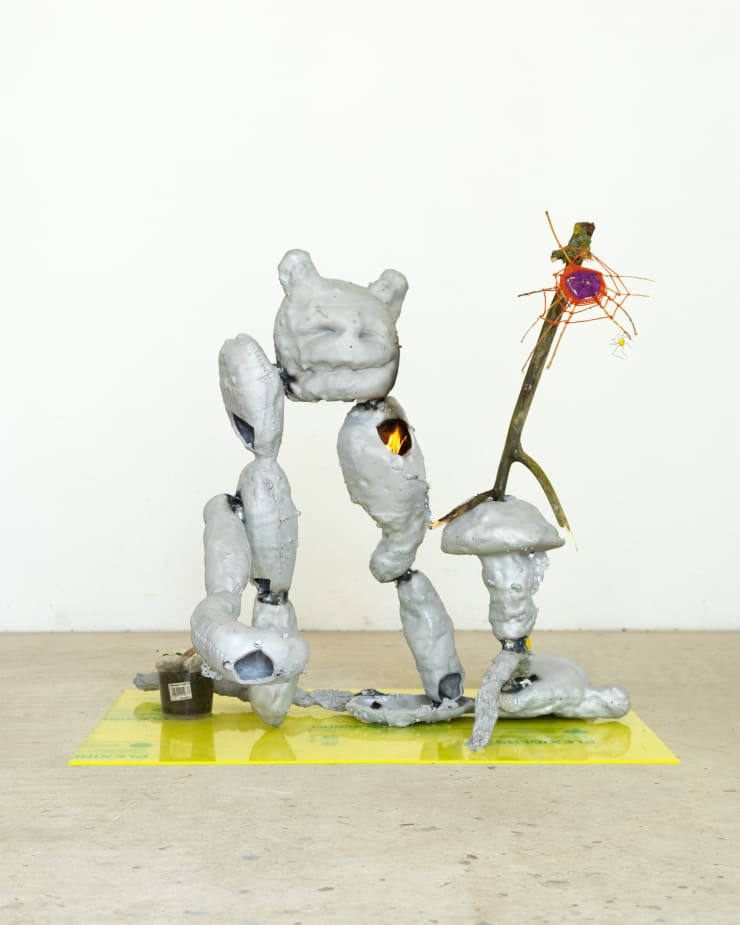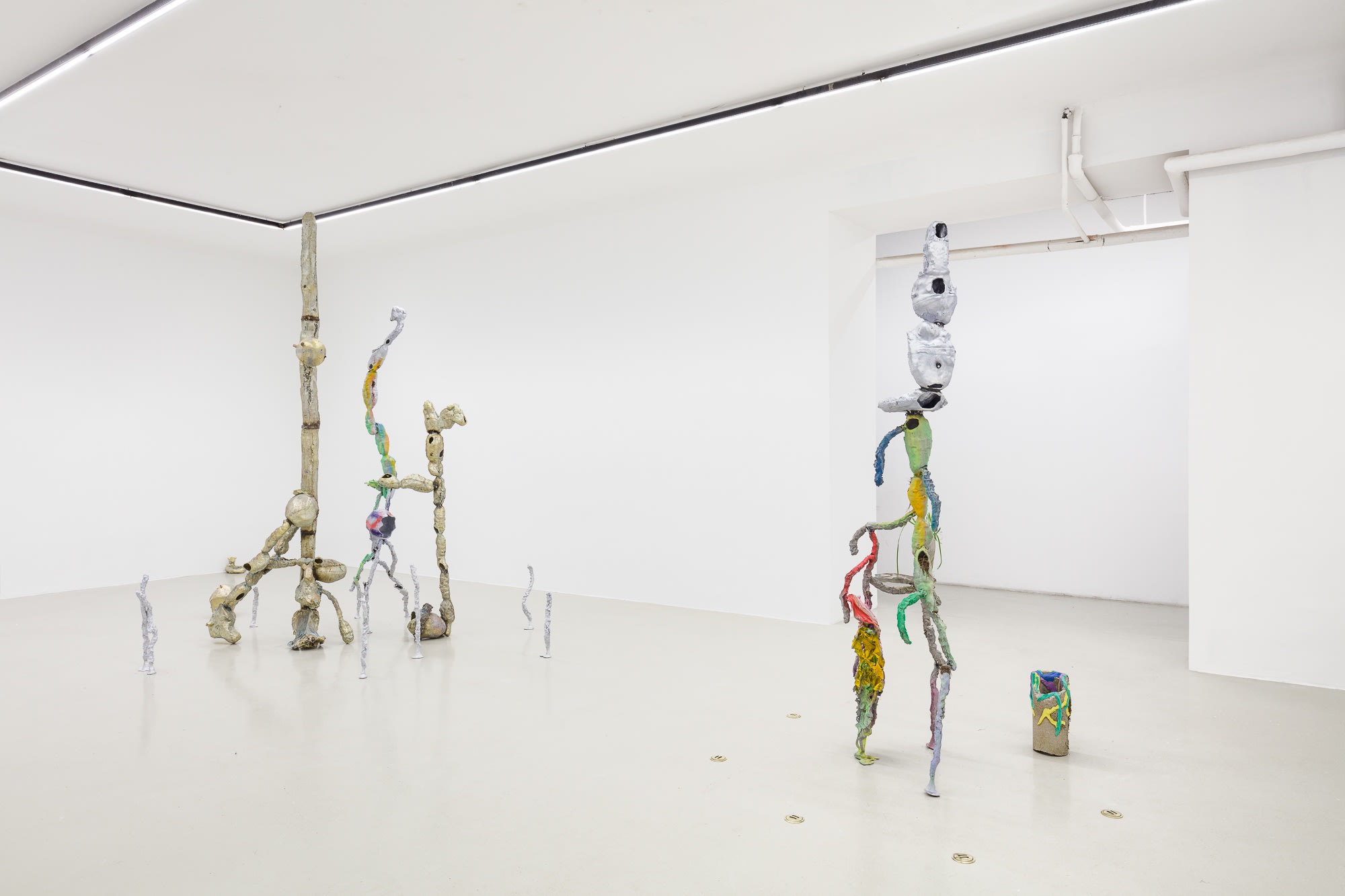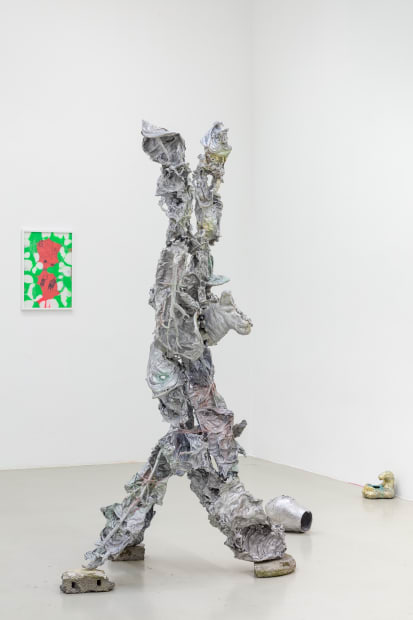-
KARL KARNER
BRUTBLADD _ THE HORSE EATS WITH ME -
The title of Karl Karner´s new group of works is given by the Bryophyllum (Brutblatt), also called "Goethe's plant". The poet, thinker and natural scientist from Weimar sought the divine in this plant and called it, due to its unusual propagation, the „pantheistic" plant.In Karner's new series, the Brutblatt plants appear in a mythically-inspired, installative setting in which a network of medial and material-technical allusions and references unfolds. A sensorially dense play of confusion unfolds between anthropomorphic aluminum casts, grotesquely overdrawn cephalopods, obscure string people and cartoonish pumpkin-head chimeras, fire bowls and planters in which things grow, wither, burn, smoke and smell. Karner mixes materials and substances, stripped of their former functional frames of meaning, into paradoxical (in)structures of meaning.
-
Brutbladd
_ the horse eats with me -
-
![Broodleaf: [bot. Bryophyllum], also called Goethe's plant; forms brood buds on leaf margins.](data:image/gif;base64,R0lGODlhAQABAIAAAAAAAP///yH5BAEAAAAALAAAAAABAAEAAAIBRAA7) Installation View, Karl Karner, Brutbladd _ the horse eats with me, 2021
Installation View, Karl Karner, Brutbladd _ the horse eats with me, 2021Broodleaf: [bot. Bryophyllum], also called Goethe's plant; forms brood buds on leaf margins.
Sometimes nature breaks into our lives as a catastrophe, a tidal wave, a forest fire. Sometimes it happens more quietly and it sneaks into the apartment as an ant on a badly shaken out picnic blanket. But always they are strange encounters, sometimes they are brutal, sometimes irritating, sometimes funny. What happens in these encounters? Do two irreconcilable opposites meet here - man vs. nature? Or do they form together something mysterious third? An ant trail in a Meissen porcelain sugar cup. A pink poodle in a barber shop. A brood leaf growing from a mixture of humus, aspirin and cleaning sponge.
Where man begins, the natural ceases. It does not stop being: nature is unmistakably there, with all its power, beauty and destructiveness. We have a body, a digestion, a sexuality - all this is undeniably natural. Only it is no longer natural to us. Our nature is a mystery to us. Man comes into the world with vestigial drives that pull him in no clear direction. What is he to do with his long limbs? Swing through the trees like a monkey? Take to the skies? Kafka writes in his diary, ‘How distant to me are the muscles of the arms’. If you look at them too intently, your limbs turn into absurdly long spider legs. The body becomes a bug. A foreign body that we must laboriously make our own again.
-
 Installation View, Karl Karner, Brutbladd _ the horse eats with me, 2021
Installation View, Karl Karner, Brutbladd _ the horse eats with me, 2021 -

Installation View, Karl Karner, Brutbladd _ the horse eats with me, 2021
-

Karl Karner, the horse eats with me, 2021
-
 Installation View, Karl Karner, Brutbladd _ the horse eats with me, 2021
Installation View, Karl Karner, Brutbladd _ the horse eats with me, 2021ABOUT THE ARTIST
Karl Karner (b.1973 in Feldbach, Austria) lives and works in Feldbach, Austria. Karner studied at the Academy of Fine Arts, Vienna under Professor Heimo Zobernig.
Selected Exhibitions: ‚AFFUS II’, Kunsthalle Feldbach, 2020; ‚AFFUS’, Galerie Kandlhofer, Wien, 2019; 'rhabarber schwarz', Artdepot Gallery, Innsbruck, 2018; 'getting down on knees and nerves‘ Collaboration with Nana Mandl, Kunsthalle Graz, 2018; 'Spiel gerade Höllentor', Galerie Lisa Kandlhofer, 2016; 'Nude Program', ABContemporary, 2016; 'Lungball', Galerie Lendl, 2016 und 'FakeFukoo', ABContemporary, 2015.
Karl Karner: Brutbladd _ the horse eats with me
Past viewing_room






![Broodleaf: [bot. Bryophyllum], also called Goethe's plant; forms brood buds on leaf margins.](https://artlogic-res.cloudinary.com/w_3000,c_limit,f_auto,fl_lossy,q_auto/ws-lisabird/usr/images/feature_panels/image/items/6a/6a1cbbeef9eb4d5386e94026ed917561/installation-view-iv-karl-karner-brutbladd-_the-horse-eats-with-me-2021.jpg)




